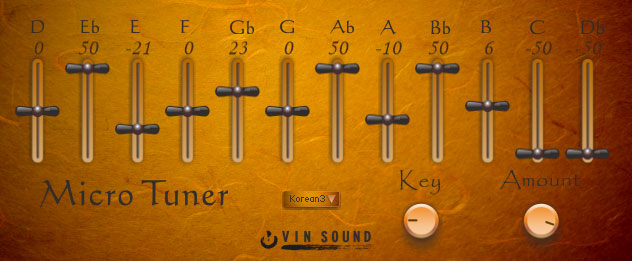The Gayageum is a 12 string zither-like instrument from Korea that has traditionally been played since the 6th century. This sample library has been beautifully produced by Vin Sound in South Korea. The library contains three patches: Solo (single instrument sample set), Ensemble (two layered sample set), and Reverse (single instrument sample set played backwards).
Main Controls
All of the patches contain a standard set of controls to manipulate the placement of the instrument within the virtual environment. The controls act behind the scenes to change the parameters of some of Kontakt’s various effects. You can disable these effects (which will reduce the CPU burden of your computer) by clicking the green/grey button next to the control’s name.
- The EQ Low and High knobs control the low and high gain of Kontakt’s Solid G-EQ.
- The Stereo Width knob allows you to increase or decrease the stereo spread of the instrument. Putting this control to its minimum setting will result in a mono sound.
- The delay knob controls the time parameter of Kontakt’s delay effect in a range of 140ms to 920ms.
- The Reverb knob controls the size parameter of Kontakt’s algorithmic reverb
Articulations & Key Switches
Solo Patch
Red Keys (articulations): There are 36 articulations which are accessed by the keys displayed in Red on Kontakt’s on-screen keyboard. The name of the selected key switch will appear in the Key Switch area on the instruments interface. Some of the key switches use the played velocity level to trigger different variations of an articulation, these are listed below followed by the names of the variations in parenthesis. The variations are spread equally over the velocity range (1-127)
- C#0: Vibrato 1 (slow, medium, fast)
- D0: Vibrato 2 (slow, medium, fast)
- D#0: Vibrato 3 (slow, medium)
- F0: Snap Vibrato 1 (slow, medium, fast)
- F#0: Snap Vibrato 2 (slow, medium, fast)
- G0: Snap Vibrato 3 (slow, medium)
- G#0: Scoop Fast (variation 1, variation 2, variation 3)
- A0: Scoop Slow (variation 1, variation 2, variation 3)
- A#0: Fall Fast (variation 1, variation 2, variation 3)
- B0: Fall Slow (variation 1, variation 2, variation 3)
Green Keys (retrigger): Pressing one of these keys retriggers the last note that was played. The retriggered sample will be one of ten vibrato variations depending on which retrigger key was pressed. The name of the variation will appear in the retrigger section of the interface.
The retrigger keys can be used to simulate the real Gayageum technique known as YounTwingGim. For example a triplet can be played A2 – G1 – G#1, and a straight 16th could be played A2-G1-G#1-A1.
Yellow Keys (effect control): There are two effect control key switches (B5, C6) that can be used to turn the delay and reverb effects on or off.
Ensemble Patch
Red Keys (articulations): This patch has two articulations (sustain and vibrato) that are accessed by keys C2, and D2. You can also switch between these articulations using the Mod Wheel (CC1) – a controller value of 1 or more will activate the vibrato articulation. The name of the currently selected articulation is displayed in the key switch area of the interface.
Yellow Keys (effect control): These function in the same way as for the solo patch.
Reverse Patch
The reverse patch contains only one articulation. This is the sustain articulation used in the solo patch but the samples are reversed. The interface contains a knob that controls the playback speed of the samples. A lower value results in a slower playback rate. This knob can also be controlled using the mod-wheel (CC1).
Yellow Keys (effect control): These function in the same way as for the solo and ensemble patches.
Micro Tuner
Each patch has a second tab that provides access to the instrument’s Micro Tuner controls. You can use the sliders on this tab to fine tune each note of the instrument in the range of -50 to +50 cents. Holding your keyboard’s control key (ctrl) while clicking the tuning sliders will reset them to their default position.
Using the Key knob you can shift the key/note that your tuning settings are applied to.
The Amount knob can be used to vary the effect the tuning settings have on the instrument.
The drop down menu in the centre of the interface provides some preset tuning options, utilising traditional Korean tunings. You can use the “Default” option in this menu to reset all of the tuning sliders to there default (centre) position.
Acknowledgements
Produced by Kevin Lee/Vin Sound





